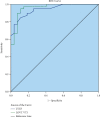Transcranial Doppler Ultrasound for Monitoring the Cerebral Hemodynamic Changes and Prognosticating Outcomes in Venoarterial Extracorporeal Membrane-Oxygenated Patients
- PMID: 36052306
- PMCID: PMC9423977
- DOI: 10.1155/2022/2912477
Transcranial Doppler Ultrasound for Monitoring the Cerebral Hemodynamic Changes and Prognosticating Outcomes in Venoarterial Extracorporeal Membrane-Oxygenated Patients
Abstract
Objective: Patients receiving venoarterial extracorporeal membrane oxygenation (VA-ECMO) support may have cerebral hemodynamic changes whose impact on patient outcome are not fully elucidated. This study aims to evaluate the correlation between cerebral hemodynamic changes and prognostic outcome in patients during VA-ECMO.
Methods: Transcranial Doppler (TCD) ultrasound examination was performed to attain the systolic velocity (Vs), diastolic velocity (Vd), mean velocity (Vm), and pulsatility index (PI) of patients undergoing VA-ECMO. Cardiac ultrasound was also performed to assess the correlation between the left ventricular outflow tract velocity time integral (LVOT VTI), left ventricular ejection fraction (LVEF), and middle cerebral artery (MCA) with the systolic peak. Moreover, we assessed the predictive value of LVOT VTI and LVEF in patients with the systolic peak. Patients were divided into survival and death groups according to the 28-day survival period. Clinical data were compared between the two groups to investigate the effects of cerebral hemodynamic changes on the prognosis of VA-ECMO patients.
Results: We found that the patient's LVOT VTI and LVEF had high predictive values for the systolic peak of the right middle cerebral artery. The initial LVEF, Vs, Vd and PI, and lactate level as well as the MODS incidence rate difference were significantly different between the survival and death groups. In addition, the results showed that the initial Vs value was an independent risk factor for the prognosis of patients undergoing VA-ECMO.
Conclusions: Cerebral hemodynamic changes may occur in patients supported by VA-ECMO. In addition, a poor cerebral arterial pulsatile blood flow was closely correlated with an unfavorable outcome in these patients.
Copyright © 2022 Man Wang et al.
Conflict of interest statement
The authors declare that they have no conflicts of interest.
Figures




Similar articles
-
[Effect evaluation of bedside ultrasound monitoring of left ventricular functional parameters combined with clinical indicators on veno-arterial extracorporeal membrane oxygenation].Zhonghua Wei Zhong Bing Ji Jiu Yi Xue. 2021 Mar;33(3):329-333. doi: 10.3760/cma.j.cn121430-20201023-00684. Zhonghua Wei Zhong Bing Ji Jiu Yi Xue. 2021. PMID: 33834975 Chinese.
-
[Transcranial Doppler monitoring of cerebral blood flow velocity during extracorporeal membrane oxygenation in sheep].Zhonghua Yi Xue Za Zhi. 2003 May 25;83(10):872-6. Zhonghua Yi Xue Za Zhi. 2003. PMID: 12895342 Chinese.
-
Quantitative evaluation of hemodynamic parameters by echocardiography in patients with post-cardiotomy cardiac shock supported by extracorporeal membrane oxygenation.J Cardiothorac Surg. 2023 Jan 4;18(1):1. doi: 10.1186/s13019-022-02074-4. J Cardiothorac Surg. 2023. PMID: 36600267 Free PMC article.
-
Retrospective Analysis of Transcranial Doppler Patterns in Veno-Arterial Extracorporeal Membrane Oxygenation Patients: Feasibility of Cerebral Circulatory Arrest Diagnosis.ASAIO J. 2018 Mar/Apr;64(2):175-182. doi: 10.1097/MAT.0000000000000636. ASAIO J. 2018. PMID: 28777134
-
Transcranial Doppler microemboli and acute brain injury in extracorporeal membrane oxygenation: A prospective observational study.JTCVS Tech. 2022 Aug 20;15:111-122. doi: 10.1016/j.xjtc.2022.07.026. eCollection 2022 Oct. JTCVS Tech. 2022. PMID: 36276670 Free PMC article.
Cited by
-
Triglyceride-glucose index and cervical vascular function: outpatient-based cohort study.BMC Endocr Disord. 2023 Sep 8;23(1):191. doi: 10.1186/s12902-023-01449-5. BMC Endocr Disord. 2023. PMID: 37684683 Free PMC article.
References
-
- Zangrillo A., Landoni G., Biondi-Zoccai G., et al. A meta-analysis of complications and mortality of extracorporeal membrane oxygenation. Critical Care and Resuscitation . 2013;15(3):172–178. - PubMed
-
- Lorusso R., Barili F., Mauro M. D., et al. In-hospital neurologic complications in adult patients undergoing venoarterial extracorporeal membrane oxygenation: results from the extracorporeal life support organization registry. Critical Care Medicine . 2016;44(10):e964–72. doi: 10.1097/ccm.0000000000001865. - DOI - PubMed
MeSH terms
LinkOut - more resources
Full Text Sources
Research Materials
Miscellaneous
